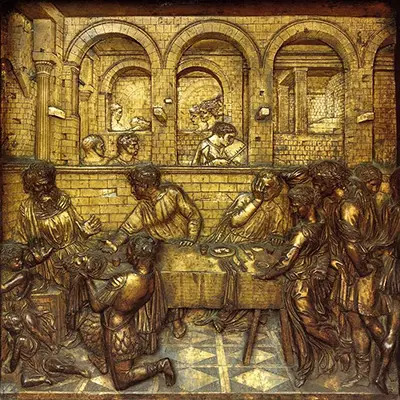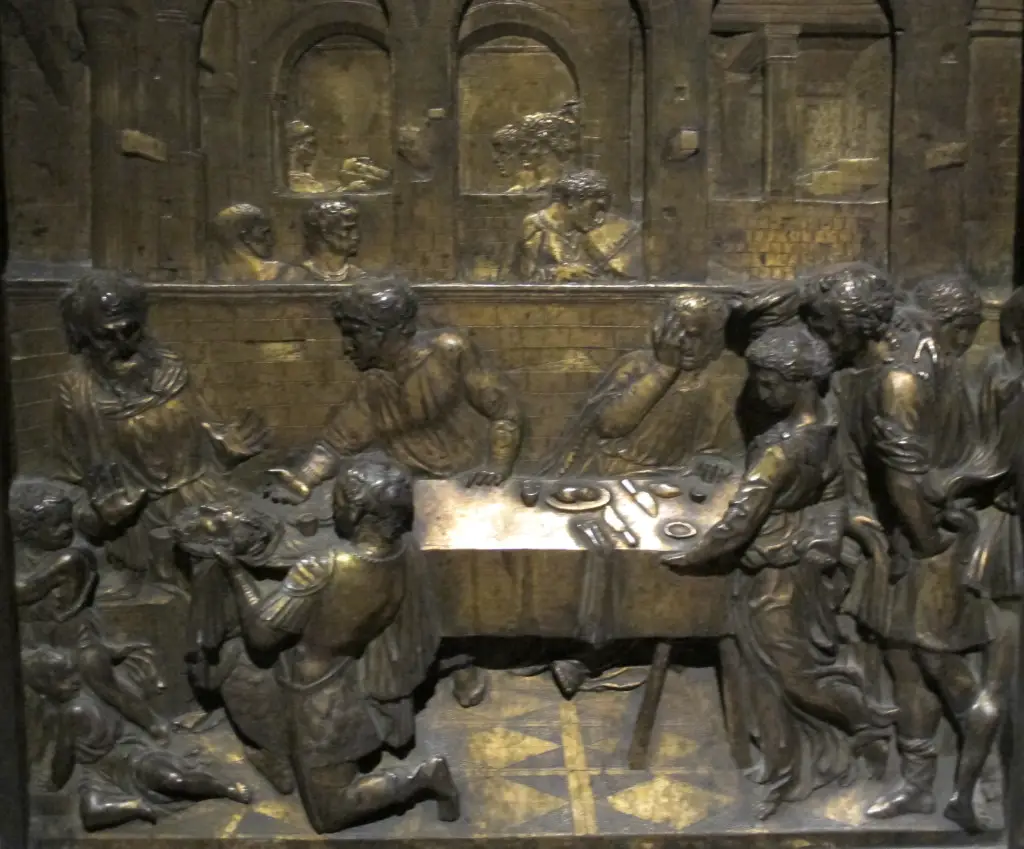The Feast of Herod can be found in the baptistry of Siena Cathedral, in Italy. It is a bronze bread relief sculpture and is one of Donatello's most famous sculptures.
The artist created the Feast of Herod in 1427. It is a very early example of Donatello's sculptures and his very first bronze relief. Over time, artists have noted the use of Donatello's use of perspective in the sculpture. The relief sculpture measures 60cm x 60cm. The relief sculpture shows the way in which John the Baptist was beheaded after his head was requested on a platter by Salome, who was Herod's daughter. The sculpture shows John the Baptist's executioner presenting his head to Herod. Herod reacts in shock. The figures are all sat around a table, in a similar manner to some of the Renaissance interpretations of the famous Last Supper passage from the Bible. A number of figures are placed on the right hand side of the piece, standing on a patterned floor. To the left we see the main characters of the story who are given room to dominate one's attention. The level of detail for this relief, with a bricked wall and several rows of arches seems an extraordinary achievement, considering the medium used.
Donatello was a well rounded artist who took influences from ancient art, and then combined them with new innovations and ideas which helped to make the Renaissance what it was. His sculptures were diverse in style, and he evolved over the period of his career, as underlined by the two different depictions that he produced of David, for example. He had studied classical sculpture as a young student and felt that many of its qualities would continue to work today. He would spend time in different parts of the country, with Italy of the 14th century being made up of a network of influential kingdoms which would regularly come into conflict with each other. The finest artists would be courted in order to embellish the key buildings in each region, producing a cultural battle that was fought between painters, sculptors and architects. Many would spread their services across different regions, with Donatello working in Rome, Padua and Siena. He was unusual as a sculptor in taking on so many different materials across his career, including stone, bronze, wood, clay, stucco and wax.
His artistic style with reliefs was unusual at the time, with items such as The Feast of Herod, The Ascension with Christ giving the Keys to St Peter, Madonna and Child all giving younger artists a different perspective on what was possible and desirable. Commissions started to come in as his reputation soared and by that point Donatello was able to pick and choose between which projects he took on. He was someone who always sought to challenge himself as much as possible, as he understood that this would lead to the greatest amount of artistic and technical development. Despite his achievements with reliefs, most of the public still know him most as a producer of statues, partly down to the fame achieved by his bronze David. Those more knowledgeable about his career, however, will see him as a rounded artist who was ambitious and played an important role within the direction of Renaissance sculpture. He is rightly regarded as similar in stature to the likes of Michelangelo and Lorenzo Ghiberti.
Table of Contents
- The Commissioning of The Feast of Herod
- Description of the Sculpture
- The Use of Linear Perspective
- The Use of High and Low Relief
- Where can the Feast of Herrod be found today?
- What is a relief sculpture?
- Did Donatello produce any other reliefs?
- What is the story of Herod?
- What and where is Herodium?
- Large Image of The Feast of Herod
The Commissioning of The Feast of Herod
It was in 1416 that Lorenzo Ghiberti was asked to work as a designer for a new baptismal font by the officials of Siena Cathedral - Opera del Duomo. The original plans depicted six relief sculptures which were to be fixed to the six sides of the font. These were to be completed by two local artists and Ghiberti. The feast of Herod by Donatello was commissioned to replace one of the six pieces of art work that was originally supposed to be done by one of the local artists. The artist was not completing the work commissioned on time and so he was replaced. Donatello completed the work in his workshop in Florence before it was transported to Siena Cathedral.
Description of the Sculpture
The scene depicted in the work shows several elements common to the Baptist cycle - another name for the important events in John the Baptist's life. Donatello brings together elements from several other important works such as Pisano's reliefs on the Florence Baptistry, as well as Salome's dance and the beheading of John the Baptist. He brings these things together using narrative art that shows several scenes of a story within a single framed work. This helps to depict the story of the beheading of St John without having to show the beheading explicitly. One of the great things about Donatello's work that is different to others is the way in which he shows the emotional response of the individuals within it, such as Herod's response.
The Use of Linear Perspective
Linear perspective is brought to the scene, the help the viewer to focus on important characters and points in the work. Donatello was very much inspired by other artists using a linear perspective. At the time of the work this was fairly uncommon. However, linear perspective was something that became a common, important feature in art created during the Italian Renaissance. Linear perspective involves representing light that moves through a pretend rectangle, known as the plane of the painting. This moves through to the eye of the viewer. It is as if a viewer is looking at a window and painting what can be seen on the window pane. If the object is viewed from the exact spot that the windowpane is painted, the image that had been painted would be exactly the same as what was seen though the window that was was unpainted. The use of linear perspective is often described as being a technique that created the mathematics of art.
The Use of High and Low Relief
This is an another method used by Donatello to discuss the space in the depicted scene. Donatello uses rilievo schiacciato, or shallow relief which he had used earlier in his image St George Predella. This was a work that was commissioned for the Church of Orsanmichele in Florence. Donatello managed to use schiacciato, or in english shallow relief to create greater depth in his fantastic work. It is actually the contrast between high and low relief that truly leads to the depth found in his work. This depth gives a great sense of realism to the viewer. The figures move into the viewers area, and helps the viewer to imagine their presence in the scene.
Where can the Feast of Herrod be found today?
The Feast of Herod by Donatello can still be viewed to this day in the wonderful cathedral in Siena. This is a very fitting location for the world to see this magnificent piece of pre-renaissance art. Donatello's work is appreciated by many hundreds of visitors everyday. The artists techniques allow all who view it to appreciate the importance of the event in religious history. It also allows the viewer to experience the emotion of the situation. Siena itself has a strong history within the Renaissance and had its own school in the earlier part which contributed a number of notable artists who would receive local commissions and also a number of requests from elsewhere in the country.
What is a relief sculpture?
A relief sculpture involves an artwork projecting from the wall behind, with variation coming in the distance to which they protrude out. Other types of sculpture can be entirely free standing, and moved around as such, where reliefs will show the background wall showing through. In one sense, they mark a mid-point between free standing sculptures and paintings, though a skilled sculptor would still be able to create perspective within them, and Donatello was able to do so within The Feast of Herod. Relief sculptures can benefit from having one side covered by the wall, meaning the artist only needs to worry about the side facing the viewer. Additionally, there are no concerns about where the item might be moved to, or how it will stand by itself and balance correctly for generations to come because the architecture will already have been built. The nature of this type of sculpture means that normally they would be used within architectural projects as important flourishes across the main structure.
Did Donatello produce any other reliefs?
There were four main reliefs by Donatello, namely the Pazzi Madonna in 1420, followed by the The Feast of Herod in 1427, then The Ascension with Christ giving the Keys to St Peter in 1432 and finally Madonna and Child from 1440. He would vary the height at which the relief would come out from the wall behind and this produced very different results within just a small sample of work. The Ascension Relief, for example, is very subtle in how the detail appears and this low rising method is generally known as rilievo schiacciato. The Feast of Herod is more contrasting in its levels, though there have been other examples of reliefs in which the detail is far more pronounced, mirroring more the other types of sculpture that were seen at that time. The more three dimensional these designs were in nature, so the amount of work needed to produce them would increase, with elements needing work from more angles.
What is the story of Herod?
Herod Antipas was a ruler of Galilee and Perea and was sometimes known as King Herod, even though he never actually achieved this title officially. He appears within the New Testament several times and these appearances relate to the deaths of John the Baptist and Jesus of Nazareth, which is perhaps why Herod is still fairly well known today. Herod Antipas was married several times and made several rulings which impacted his close family in what was a particularly complex and unstable environment. Some have suggested that actually it was Herod Antipas that ordered the crucifixion of Jesus, but this is a minority view. Several close friends and family members would spread knowledge about his rule to an early Christian movement which perhaps explains his somewhat heavy handed approach to dealing with real or potential opponents, though his fears would be realised when he spent his last days in exile with his wife, Herodias.
What and where is Herodium?
Herodium is believed to be the burial spot of Herod Antipas's father, Herod the Great. It is a round-shaped hill with a flat top which lies close to the city of Jerusalem. It is also known in other languages as Har Hordus or Jabal al-Fureidis. The King would build a large complex around this location, though none of it exists today other than the original mound. The entire region remains under dispute between Israel and Palestine. Herod the Great would rule over the Herodian kingdom of Judea, a region which today falls across the territories of Israel, Palestine, Jordan and Syria. He himself would appear within the Gospel of Matthew, with his son then also featuring in items such as The Feast of Herod as found in this page. Both were considered aggressive rulers, though this was far from uncommon at that time. A family tree helps to underline how the marriages that they arranged were all interconnected with other families, with regular conflicts when some of these relationships broke down or became embroiled in the endless political quarrels.





